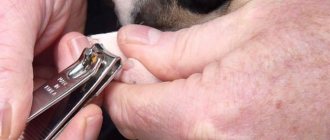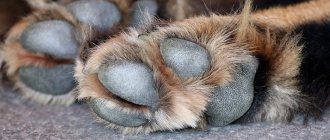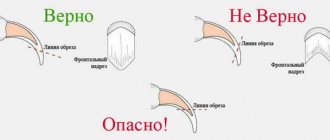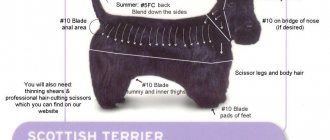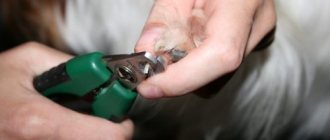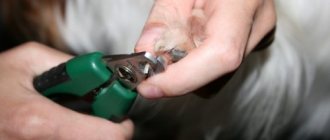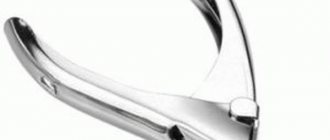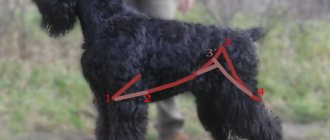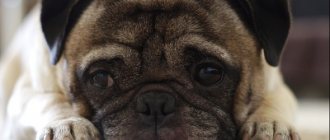For many domestic cats, nail trimming is a must. Growing nails cause discomfort to animals, and if they are not shortened in time, inflammation may begin. However, you need to properly prepare for a cat “manicure” and learn the technique of performing it. Then the procedure will take place with minimal stress and will not cause pain to the cat.
Why trim your cat's claws?
The joy of acquiring a furry neighbor is often replaced by concerns about the animal’s behavior. If a cat has not been accustomed to a scratching post since childhood and is inclined to swing its paw at the owner’s hand, there is a risk of getting an unpleasant surprise in the form of frequent scratches. Trimming cat claws is necessary and can be done at home:
- If your pet has an increased interest in furniture, this can completely ruin a sofa, armchair, set, or even renovations.
- If the pet has an aggressive character and has repeatedly scratched and injured its owners, family members and guests.
- If your pet is participating in shows: show breeds (British, Russian Blue, Maine Coon) may be disqualified for having untrimmed nails.
- There are pathologies in which animals have deformed phalanges and claws that grow into the paw pads. In this case, trimming the claws is a necessary procedure.
IMPORTANT: claws are an important tool of feline nature. Animals use their claws to hunt, climb to surfaces, and defend themselves. Completely declawing a pet is inhumane and unsafe for the animal's future life.
Nail trimming is a safe and necessary procedure for indoor cats.
Claw diseases in dogs
Improper or insufficient care of your dog's nails can lead to many unpleasant consequences:
- Ingrown claw. Untimely trimming or leaving the fifth toe untreated can cause the claw to bend and grow into the pad of the toe.
As the claw grows in, it disrupts the integrity of the skin; bacteria can enter the wound or fungus can develop. The dog experiences pain and does not stand on its paw: the stronger the discomfort, the less the paw is involved in walking.
- Inflammation of the claw bed, or panaritium. This condition can result from injury to a finger, claw, or adjacent tissue. The inflamed area becomes hot, swelling appears, inside which pus accumulates. Due to inflammation, the body temperature may rise, and the dog may experience loss of appetite. A dog's paw may smell unpleasant when the abscess opens and pus drains out.
- Breaking off a claw. It is also an extremely painful condition. When the claw is too long and catches on surfaces, with a sudden movement, the tip of the nail can break or come off completely - often breaking the blood vessel inside the claw. Almost always, breaking off a nail leads to severe bleeding - the dog cannot stand on its paw due to severe pain.
In some cases, the dog owner can treat the dog's painful condition on his own. For example, with felon - in the early stages of the development of the disease, it is necessary to carry out antiseptic treatment with various solutions (for example, chlorhexidine) with the application of wound-healing dressings. Bandages need to be changed periodically and make sure that the pet does not remove the bandage himself. You can use a special veterinary cap until the wound heals.
If a claw breaks off, you must first stop the bleeding, and then treat it and apply a bandage. If the claw does not break off very close to the pad, you can do without veterinary help.
However, with more serious consequences, when the dog does not stand on its paw at all, does not allow it to be examined or treated, with an ingrown claw, or if the paw is severely inflamed and the animal has a rise in body temperature and a general depressed state, you cannot do without an ambulance from a veterinarian. In such cases, surgery will most likely be required - under general anesthesia and under sterile conditions.
Preparing for your first haircut
Trimming nails should become a familiar procedure for your pet from an early age. You should periodically pick up the kitten in your arms and, pressing slightly on the pads of its paws, allow it to release its claws, while simultaneously massaging its paws. Over time, when the kitten begins to calmly respond to manipulation, it will be useful to reward it with treats, thereby reinforcing the positive habit.
IMPORTANT: a kitten should have its claws trimmed when it is 2 months old.
Ideally, the pet should be indifferent to the procedure.
The procedure can only be carried out when the animal is in a completely calm state. It is strictly forbidden to use physical force and raise your voice at your pet, but it is still necessary to show persistence: there is a chance that the pet will begin to worry and break out.
Talk affectionately, pet and treat your pet, and enlist the help of someone who can hold the animal. Do not insist on the procedure if the cat screams loudly and breaks out, this is fraught with psychological trauma and severe stress. Be patient if you want to make bone trimming a habit in your pet's life.
Is it possible to cut while the animal is sleeping?
Trimming the claws of a sleeping animal is not recommended. As a rule, cats are very sensitive animals and they also sleep lightly. During sleep, an animal can be easily frightened, and this can become very stressful and have unpredictable consequences: the cat will begin to be afraid of you and avoid you, in the future it will not allow you to touch its paws, much less cut its claws.
To carry out the nail trimming procedure, your pet must be as calm as possible, but in no case defenseless.
Haircutting tools
First of all, to successfully perform a cat manicure, you need to acquire a tool. In specialized pet stores and veterinary pharmacies you can find all the equipment necessary for the procedure:
- Nail clipper-scissors. In appearance it resembles ordinary nail scissors, but with notches on the blade. It is in these grooves that it is convenient to insert a cat's claw so that it does not slip. The device allows you to quickly and evenly shorten claws.
- Trimmer in the form of a guillotine. The tool resembles pliers with a ring instead of blades. The trimmer is easy to use and very popular among experienced owners. Beginning cat breeders may have difficulty determining the length of the claw to cut.
- Nail clipper. The device is safe to use, as it has a locking system that prevents the blades from closing.
- Veterinary clinics and animal care salons use electric nail clippers, which are classified as professional tools.
Nail trimming tools
In a wide selection of cutting devices, the owner is often confused about how to trim a cat’s claws. If you have little experience in this procedure, then you should choose a nail clipper or scissors. The choice of tool also depends on the condition of your pet’s claws. If they are thin and transparent, then scissors or pliers will do the job, but if the claws are dense and thick, then a guillotine trimmer will be the best option.
At home, you can also use nail scissors or clippers to perform the procedure. In addition to the cutting tool, you will also need a hard nail file or emery block for correction after trimming. Just in case, you need to arm yourself with cotton swabs and 3% hydrogen peroxide.
Which nail clipper to choose for a dog
Classic scissors should not be used, just like regular wire cutters. Dog handlers advise taking only a few specially designed tools to correct claws.
They can be purchased at veterinary pharmacies or pet stores. The device is called a claw cutter. It is this that will help you, with a light press, remove the dog’s claw to the desired length without splitting its surface. The size is selected based on the breed of the dog.
You can purchase several types of tools suitable for your favorite dog’s claws - first study the assortment, then make a choice. Buy special metal-reinforced scissors, a guillotine, tweezers or a machine. Devices made of steel or brass work well.
The handle of any cutting tool should be comfortable for the hand and rubberized - the process is tiring, especially the first time. Non-slip coating on the handles is necessary to prevent the hand from slipping and the dog from being injured.
Sharp blades without chips or nicks will quickly and easily cut off the tip of a claw, even the thickest one.
Special scissors
The scissors, which look so similar to garden pruners, have two blades. One is curved and looks like a hook. The blades are attached to two handles, making them easy and convenient to operate.
Models with a built-in limiter have an advantage, making grooming safer. They are used to cut small breeds of dogs, but large dogs have harder claws and the scissors may not be able to cut them.
global $ads_google; //data-ad-slot=”2475549904″ $ads_google = empty($ads_google) ? false : true; ?> if ($ads_google == false) {?>
$ads_google = true; ?> } ?>
Guillotine
The tool is named so because of its similar operating principle to a real guillotine. The plate has a slot for a claw and a lever handle. The action is simple - the levers are activated, and the claw is cut off instantly.
The guillotine comes in different sizes, so you can choose a tool for any dog, both tiny and huge in size.
Machine and other tools
A file is needed not only for grinding down a human nail. It is worth purchasing a hand file for filing cut dog claws. Immediately, small scissors are also purchased for your arsenal, always with rounded edges. They cut off the hair between the fingers. Dog grooming should be complete!
There is also a grinder for cutting nails. Despite its convenience, such a device also has a drawback. The machine works noisily, this sound frightens the animal or simply irritates it.
Grinding a claw takes longer than simply cutting it off. Not every dog will sit quietly and watch the “execution”. The clipper can injure the paw pads, and such a wound is more dangerous and serious than an incorrectly cut claw.
The convenience of the machine is that it has several attachments for claws of different hardness.
If you wish, you can buy several tools so that you can choose the most convenient one in the process.
Age and purpose
Cats are pets that are often kept at home, so you need to know the basic requirements for caring for them. Since animals are wild and capricious by nature, the presence of sharp claws can be quite dangerous for others. To minimize risks, you need to be able to trim a cat's claws if the need arises.
There are the following reasons why this procedure is mandatory:
- keeping a cat exclusively at home;
- lack of significant activity in the animal’s behavior;
- assistance in grinding down claws if the pet cannot do it on its own;
- too violent and unbridled character, which threatens the health of others.
If in the first three cases the manicure procedure is desirable, then in the last one it is necessary to trim the cat’s claws, because anyone can get hurt, including children. The procedure for shortening the nail plates can be carried out on all four paws so that the cat does not feel discomfort, understanding the difference in sensations in front and behind, and is also completely harmless. If the pet does not show aggression, then trimming and filing the claws on the hind legs can be omitted.
It is not recommended to do this procedure too often, as this can negatively affect the cat’s health. There are also certain age limits when it is worth starting such procedures in order to accustom your pet to them and not have problems with it in the future. The optimal period would be the age of two to three months, when the claws have already become stronger and can be cut off, and the pet is still small enough to protest, but is quite capable of gradually getting used to the manicure.
Carrying out similar actions for smaller kittens is harmful, since their claws are still too tender and you can cause pain to the pet by cutting them too much.
You can cut the nail plates of a cat or kitten only if you have some experience or knowledge of how the process itself should be carried out correctly. The first time is always the most difficult, both for the cat and for the owner, so it is important to prepare mentally and create all the conditions for the work to be carried out successfully. To keep the kitten from getting nervous, you need to pet it, talk to it, and treat it to something tasty. The procedure will no longer be scary and unpleasant for the animal when it feels safe and expects a reward after the manicure is completed.
Once the procedure has become habitual for your pet, it is worth deciding on its frequency so as not to worsen the condition of the claws and not to overdo it with shortening them. For each cat, the number of such sessions may differ, which is explained by individual developmental characteristics, activity level and age. The optimal norm is to trim claws once a month.
If we talk about kittens, then they are actively growing not only their bodies, but also their nail plates, and therefore they will have to be shortened 2 times more often.
scratching post
Monthly nail trimming does not always relieve your cat of the need to take care of her claws on her own. If you see that your pet, despite timely care, periodically looks for materials on which it wants to “practice,” then it makes sense to think about buying a scratching post. A scratching post will allow the cat’s other needs, which we talked about earlier, to be realized. Marking territory, kneading muscles, grinding claws - all this will be provided by a scratching post for your pet.
A flat scratching post is a convenient place to start introducing your cat to such devices.
Please note that not all cats accept scratching posts. There are times when owners, having bought a huge gaming complex for their cat, sell it as completely unnecessary. To decide whether your pet is interested in this type of leisure activity, you can start by getting acquainted with such a simple and cheap option as a flat scratching post. It is upholstered with a special hard material that allows the cat to successfully tear at it. Attached to some vertical surface, it will give your dog an initial idea of scratching posts and allow you to predict his reaction to such devices.
For some cats, the purpose of the scratching post remains a mystery.
A flat scratching post needs to be hung high enough so that the cat can stretch all its muscles while sharpening its claws. The minimum mounting height for such a scratching post is eighty centimeters.
Types of scratching posts
In addition to the flat version, there are the following types of scratching posts:
- Post – A cylindrical post covered with a stiff material (such as jute). At the top of such a pillar there is usually a platform on which the pet can climb if desired. Sometimes the posts are equipped with additional toys to attract attention, sometimes they make do with a minimalist design. You can make a claw post with your own hands by taking a leg from a table or coffee table and upholstering it with the appropriate type of fabric;
The stand is suitable for both adults and little ones
- A scratching post built into the play complex. On the Internet you can find many design solutions for the location of entire cat “palaces” in apartments. They combine posts, flat scratching posts, beds, and everything you can imagine. It would seem that the cat’s leisure time in such conditions is guaranteed, but sometimes it happens that the pet remains completely indifferent to such “architectural ensembles” in his honor;
Play complexes are upholstered with the same materials as flat scratching posts
How to prepare for the procedure
The owner must know how to prepare for pruning. Most pets initially resist pruning with all their might. It is important to properly prepare your animal. It is better to choose a time when he is relaxed and in a good mood. You need to start with a paw massage so that the pet does not feel discomfort. Attention switches to other activities and objects.
In the first months, the kitten experiences fear, fear and even irritation. It can break free and run away, and if held by force, it can even bite or scratch a person.
You should not use physical force, as it is necessary to convince your furry pet that this procedure is absolutely safe for him, that he has nothing to be afraid of. Trimming should be done regularly; the animal will gradually get used to it.
Over time, a habit will appear, and to make this happen faster, you can use encouragement in the form of something tasty. In order for pruning to be taken calmly, you should not expose your pet to stress. The owner should talk to him affectionately and stroke him. If the cat is too scared, it is better to postpone the procedure.
What is required for the procedure?
Suitable tools are required to carry out the procedure correctly. Ordinary scissors will not work; you need to buy a special nail clipper. It is recommended to choose a tool carefully, taking into account the size and breed of the dog. It is worth paying attention to the following parameters:
- blade material – preferably brass or stainless steel, preferably with chrome plating;
- handles should be rubberized so that they do not slip;
- cast construction, fastened with reliable rivets;
- the tool should be comfortable to hold.
There are two types of nail clippers on sale. Secateurs that resemble scissors, only with a special blade shape. One of them is curved, the other is straight. Secateurs are convenient for small breeds; large dogs may not be able to handle the hard keratin layer.
A guillotine-type nail clipper is suitable for claws of any thickness. You just need to choose a tool that is suitable in size. This nail cutter consists of one blade with a hole. A claw is inserted into it and a lever-like handle is pressed. This is a professional tool, it is more difficult to use.
It is also recommended to purchase a file. With its help, they sharpen the claw, giving it the necessary shape, and smooth out irregularities. This helps prevent delamination. The file can be manual or electric. The machine is equipped with different attachments. If you choose a high-quality file, you can do without a nail clipper. Although many dogs are scared by the sound of an electric clipper, it also takes a lot of time to clean their nails with it.
How to trim a cat's claws yourself?
Preparation begins at the moment when the animal does nothing: does not eat, does not sleep, does not play and does not lick itself. Take your pet in your arms, talk affectionately and communicate. Lightly touch the paw pads, massage them, while trying to distract your pet's attention. It is advisable to enlist the help of someone whom the cat knows and trusts.
- Place your pet on a stable surface.
- Take the paw, gently massage and press on the pads, do this with each paw.
- If your pet reacts well and doesn’t break out, give him a treat.
Below you will learn how to trim a cat's claws using scissors and a nail clipper at home.
How to properly trim a cat's claws with scissors at home
Prepare:
- Scissors (blister)
- File
- Cotton pad
- Hydrogen peroxide
Before the procedure, wash your hands, clean and disinfect instruments.
The pink part is the vessels and pulp
- Carry out the procedure in a room with good daylight.
- Sit comfortably and place the cat on your lap, stroking and calming your pet.
- Take the paw in your hand, massage it, and as soon as the cat releases its claws, start trimming.
- After trimming your pet's claws, treat them with a file so that the animal does not cling to surfaces.
The photo shows a diagram of how to properly trim a cat's claws without damaging the pulp.
IMPORTANT: take special care if the cat’s claws are black - leave extra length for safety.
Do-it-yourself haircut with a nail clipper
A nail clipper allows you to safely trim your nails to the desired length. Using a nail clipper, it is almost impossible to accidentally injure an animal, but you should cut carefully so as not to touch the blood vessels.
Prepare:
- Claw clipper
- File
- Cotton pad
- Hydrogen peroxide
Before the procedure, wash your hands, clean and disinfect instruments. Next, follow the familiar instructions:
- Choose a well-lit room.
- Sit the animal on your lap, calm and stroke it.
- Allow your cat to release her claws by gently pressing on the pads of her paws.
- Carefully guide the movements of the nail clipper at the correct angle so that after the procedure the claw resembles an “arrow”.
You can leave extra length to be on the safe side.
All claws in one session, or one paw every day?
Everyone chooses a nail trimming scheme according to their own employment and the level of patience of the animal. How to trim a cat's claws in one fell swoop if she gets nervous and struggles? A short-term procedure in this case is impossible a priori, since everything may end with more or less neatly trimmed claws, but an unpleasant side effect can manifest itself in the form of irritation of the owner and severe fright of the animal.
After treating the claws, you need to praise the cat for its endurance
More humane, although it takes much longer, would be to repeat the procedure every day - it takes much less of the owner’s nerves per paw, and the cat will get used to the procedure in 4 days and will behave much calmer.
After treating the claws, you need to spend some time with your pet, praise him for his endurance (animals understand this very well), play with him, and treat him with a treat. This way, the animal will not develop a final and irrevocable aversion to trimming its claws - it will be interested in the process being completed as quickly and efficiently as possible, because it is followed by a reward.
If you notice blood on a claw, you should not panic
Alternative Methods
If your cat categorically refuses to get a pedicure and it is inconvenient to take him to the veterinary clinic every month, you can consider alternative methods:
- Anti-scratch. Special overlays (caps) prevent damage to the furniture, but it is uncomfortable for the animal to walk, and the horny plates still grow and need to be cut off.
- Onychectomy or soft paw surgery. A difficult procedure for the animal, during which part of the cat’s fingers is taken away. Animals' paws become deformed, they lose coordination, and suffer from pain. Condemned by many veterinarians and breeders. In a number of countries the operation is prohibited.
Fingers
For many people, the phrase “cat toes” sounds unusual, but it is completely anatomically justified. Probably the reason for the misconception that cats have claws growing straight from their paws comes from the fact that the cat's toes are hidden under a layer of fur.
The fifth toe on the forelimbs most often remains invisible to the owner
On each cat's paw there are several toes, from which claws already grow. Unlike people, cats have a total of 18 fingers and the same number of claws:
- Cats have five toes on each of their front paws;
- The hind legs are equipped with only four toes.
The different number of fingers is associated with different functions that the hind and forelimbs are endowed with. The hind legs are used primarily as a support, while the front legs are an important defensive and hunting tool. Due to the divergent tasks, the structure of the claw on the front and hind paws is also different. The front claws are sharper, but at the same time brittle. They are more susceptible to delamination. The claws on the hind limbs are replaced less frequently and are more hard.
Polydactyly is common among both humans and animals.
The phenomenon of polydactyly or polydactyly also applies to felines. Exceeding the normal number of toes usually does not prevent cats from living and hunting. The Guinness Book of Records contains information about a record-breaking cat from Ontario with a total of 27 toes.
How often to trim nails
Experienced breeders who are interested in how often to trim a cat's claws advise trimming them as they grow. Typically this procedure should occur once every 10-14 days. But this is a common opinion, and in fact, the frequency of claw trimming will largely be determined by third-party factors:
- personal characteristics of the body (speed of nail growth);
- color of the nail plate (light nails grow faster than dark ones);
- activity of the cat (more frisky animals, often playing in the apartment or spending time outside, take care of the sharpness of their claws, regularly sharpening them, as opposed to their lazy relatives, who often spend time half asleep).
- No one can say with certainty how often to trim a cat’s claws, so in each case it is necessary to determine the frequency of trimming on an individual basis.
It is a common belief that the claws on the hind paws do not need to be trimmed. You should not check the correctness of this statement on your own furniture.
If a cat is participating in an exhibition or is about to be bred, it is imperative to trim its claws the day before.
General recommendations for the frequency of nail trimming
- Animals leading an active lifestyle, who run a lot, play and use a cat scratching post, should have their nails trimmed no more than once a month or even less often.
- Old or lazy cats that move little and mostly lead a sedentary lifestyle should have their claws trimmed twice a month.
Which animals are not recommended for the procedure?
There is no need to trim the claws of a cat that roams freely outside. She needs her nails to climb trees, hunt and defend herself from other four-legged animals.
Also, the procedure is not performed on kittens under 1 month of age. Their claws are not yet formed. Early cutting negatively affects the structure of the nail plate and leads to delamination.
But already at 2 months the claws are strongly extended, and the kitten begins to scratch. At this time they can already be cut.
What should you do if your cat doesn't want her nails trimmed?
Not all cats like having hygiene procedures performed on them, especially nail trimming. Some of them may be nervous, grumble, wag their tail threateningly, and some even strive to scratch or bite their owner. Therefore, if a cat shows particular aggression during a haircut, then you need to follow certain rules and recommendations in order to carry out the procedure safely:
- The grooming procedure should be done at a time when the cat is most calm and peaceful.
- Before trimming a cat's claws, you can swaddle him - this will save the owner's time, and he will remain without scratches or bites.
- You need to constantly pet the cat and speak kind words to it to relieve excess stress and aggression.
- Claws need to be trimmed when the animal has completely released them from the pads.
- After trimming the cat's claws, you need to give it its favorite food or something tasty.
What to do if blood comes from the claw
Rarely does a haircut succeed without incident - either the cat twitched, or the hair was too long. The main thing is to be prepared for anything. What do veterinarians say?
At home, only hemostatic powder or dry potassium permanganate are available. She can only stop the bleeding on her nails, but not on her skin - it risks a chemical burn.
In all cases, not excluding the above-mentioned bleeding, veterinarians are of the opinion that the care was professionally provided.
It is better not to carry out such procedures on your cat yourself - or first get advice and advice from a veterinarian.
Is it necessary to remove claws?
Don't remove the claws! During onychectomy, not only the plate is removed, but also the phalanx of the finger from which it grows. Only a very young cat can survive surgery without consequences, and the procedure itself carries many risks.
Among them:
- blood loss;
- infection;
- nerve deformation;
- disturbance of gait, balance, coordination due to the fact that the pet will be forced to step on the pad and not the fingers;
- deterioration of character due to the fact that the cat feels vulnerable and unable to defend itself.
Instead of removing the plate, trim it regularly, use a scratching post. If you don't have time to trim, buy soft silicone covers for cat nails. As the plates grow, they come off (after 2-4 weeks), and the procedure must be repeated. During this time, the claws become soft and dull, and therefore the cat will not be able to damage the furniture with them.

